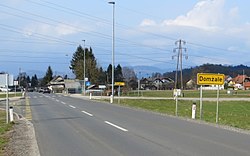Domžale
Domžale | |
|---|---|
 | |
 Domžale Location in Slovenia | |
| Coordinates: 46°8′22″N 14°35′42″E / 46.13944°N 14.59500°ECoordinates: 46°8′22″N 14°35′42″E / 46.13944°N 14.59500°E | |
| Country | |
| Traditional region | Upper Carniola |
| Statistical region | Central Slovenia |
| Municipality | Domžale |
| Area | |
| • Land | 5.2 km2 (2.0 sq mi) |
| Elevation | 304 m (997 ft) |
| Population (2016)[1] | |
| • Total | 12,863 |
| • Density | 2,474/km2 (6,410/sq mi) |
| Time zone | UTC+01 (CET) |
| • Summer (DST) | UTC+02 (CEST) |
| Postal code | 1230 |
| Vehicle registration | LJ |
Domžale (Slovene pronunciation: [dɔmˈʒàːlɛ] (![]() listen);[2] German: Domschale)[3] is a town and the seat of Municipality of Domžale. The town lies near the foothills of the Kamnik Alps and is crossed by the Kamnik Bistrica River. It includes the hamlets of Zgornje Domžale (pronounced [ˈzɡóːɾnjɛ dɔmˈʒàːlɛ];[4] German: Oberdomschale),[3] Spodnje Domžale (pronounced [ˈspóːdnjɛ dɔmˈʒàːlɛ];[5] German: Unterdomschale),[3] and Študa.[6] Domžale is known today for its small businesses, agriculture, and light industry.
listen);[2] German: Domschale)[3] is a town and the seat of Municipality of Domžale. The town lies near the foothills of the Kamnik Alps and is crossed by the Kamnik Bistrica River. It includes the hamlets of Zgornje Domžale (pronounced [ˈzɡóːɾnjɛ dɔmˈʒàːlɛ];[4] German: Oberdomschale),[3] Spodnje Domžale (pronounced [ˈspóːdnjɛ dɔmˈʒàːlɛ];[5] German: Unterdomschale),[3] and Študa.[6] Domžale is known today for its small businesses, agriculture, and light industry.
Name[]
Domžale was attested in written sources circa 1200–1230 as Domsselsdorf (and as Vnheilden dorf in 1260, Vnsselsdorf in 1302, Vnsersdorf in 1322, Dumsel in 1490, and Damschale in 1558, among other variations.) The medieval German name Unser(s)dorf is derived from (D)unselsdorf, which was presumably borrowed from the Slovene name and from which the initial D- was lost because it was reanalyzed as a definite article. The Slovene name could be reconstructed as *Domžaľe, based on a Slavic personal name such as *Domožalъ and referring to an early inhabitant of the place. Alternatively, the Slovene name may be borrowed from Middle High German Domsell(sdorf), based in turn on a Slavic name such as *Domoslavъ. In the local dialect, the town is referred to as Dumžale.[7] In the past the German name was Domschale.[3]
History[]
Domžale became a town in 1925 and a city on 19 April 1952. In the following years, Domžale became an industrial center with strong chemical and textile industry. In 1980, the construction of modern apartments began and Domžale became known as a bedroom community of Ljubljana. After Slovenia declared independence, on 27 June 1991 the Yugoslav army attacked barricades in the town, and bombed the radio transmitter and houses.
Church[]

The church in Domžale is dedicated to the Assumption of Mary. It is surrounded by a cemetery and stands on a hill just north of the new municipal cemetery.
Radio transmitter[]
The Domžale radio transmitter, the most powerful transmitter in Slovenia, is located near Domžale. It operates on medium wave frequency 918 kHz and can be received at night throughout Europe. It uses a 161 m guyed steel tube mast as an aerial.
Sports[]
Notable people[]
Notable people that were born or lived in Domžale include:
- Ivan Ahčin (1897–1960), sociologist and journalist[6]
- (1870–1948), writer and composer[6]
- Tine Hribar (born 1941), philosopher and public intellectual[6]
- (1900–1963), architect and ethnologist[6]
- (1879–1961), journalist and librarian[6]
- (1860–1935), composer[6]
- (1899–1986), composer[6]
- Radovan Trifunović (born 1973), basketball coach
- Dalibor Stevanović (born 1984), football player
Gallery[]

The Menačenk House
References[]
- Notes
- ^ "Population by settlements, detailed data, Slovenia, 1 January 2016". Statistical Office of the Republic of Slovenia. Retrieved 29 December 2016.
- ^ "Slovenski pravopis 2001: Domžale".
- ^ Jump up to: a b c d Leksikon občin kraljestev in dežel zastopanih v državnem zboru, vol. 6: Kranjsko. 1906. Vienna: C. Kr. Dvorna in Državna Tiskarna, p. 24.
- ^ "Slovenski pravopis 2001: zgornje". "Slovenski pravopis 2001: Domžale".
- ^ "Slovenski pravopis 2001: spodnje". "Slovenski pravopis 2001: Domžale".
- ^ Jump up to: a b c d e f g h Savnik, Roman (1971). Krajevni leksikon Slovenije, vol. 2. Ljubljana: Državna založba Slovenije. pp. 83–84.
- ^ Snoj, Marko. 2009. Etimološki slovar slovenskih zemljepisnih imen. Ljubljana: Modrijan and Založba ZRC, pp. 118–119.
- Sources
- Bernik, Franc. Zgodovina fare Domžale, 2 vols. Kamnik, 1923; Groblje, 1939.
- Klobčar, Marjana. Občina Domžale (Etnološka topografija slovenskega etničnega ozemlja - 20. stoletje). Ljubljana: Znanstveni inštitut Filozofske fakultete, 1989.
External links[]
 Media related to Domžale at Wikimedia Commons
Media related to Domžale at Wikimedia Commons- Domžale at Geopedia
- Official page of the municipality (in Slovene)
- Boštjan Burger's cultural heritage website, Panoramic view of Domžale
- Domžale
- Populated places in the Municipality of Domžale
- Cities and towns in Upper Carniola


